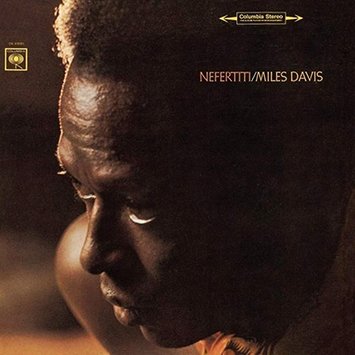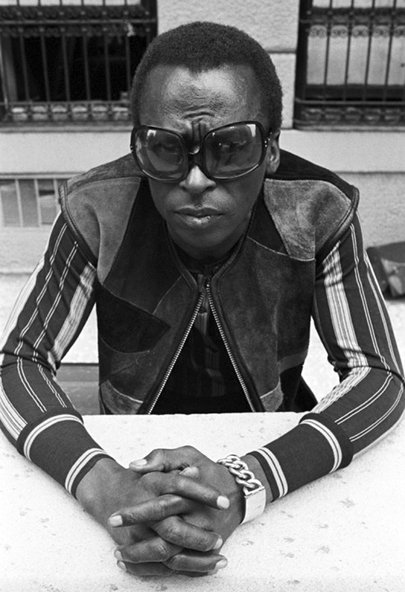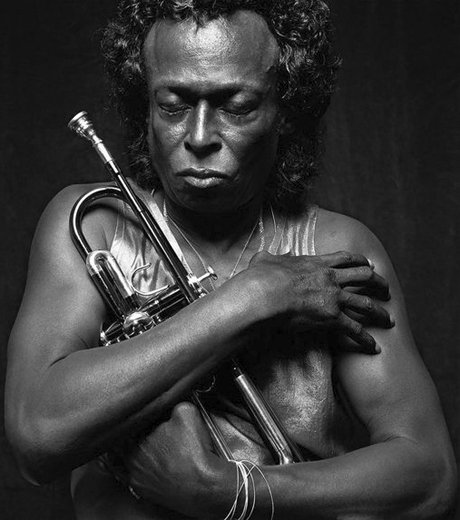Jazz post-bop: «Nefertiti» y «Fall» [ESP/ENG]
(Edited)
Nefertiti
Wayne Shorter (saxo tenor), Miles Davis (trompeta), Herbie Hancock (piano), Ron Carter (contrabajo) y Tony Williams (batería). Extraído del álbum Nefertiti (1968) de Miles Davis.
Este es el cuarto álbum que grabó Miles Davis con su segundo gran quinteto. Fue el último completamente acústico y los temas fueron compuestos por Wayne Shorter y Herbie Hancock. Este álbum continúa el avance del anterior siguiendo un camino exploratorio y ofreciendo temas reconocibles, pero deliberadamente disonantes. Mientras que en Miles Smiles encontramos post-bop agresivo, expansivo y excéntrico, aquí el ambiente es más anhelante, otoñal y profundo, incluso en los temas más rápidos. Las partes individuales se entrecruzan de manera impredecible creando insinuantes paisajes sonoros flotantes. Esta música anticipa la llegada del siguiente álbum impresionista In a Silent Way, pero permanece arraigada en el hard bop, especialmente cuando el ritmo es más rápido.
This is the fourth album recorded by Miles Davis with his Second Great Quintet. It was the last one completely acoustic and the tracks were composed by Shorter and Hancock. This album continues the advance of the previous one following an exploratory path and offering recognizable but deliberately dissonant themes. While on Miles Smiles we find aggressive, expansive and eccentric post-bop, here the mood is more longing, autumnal and deep, even on the faster tracks. The individual parts intersect in unpredictable ways creating insinuating floating sound landscapes. This music anticipates the arrival of the next impressionist album In a Silent Way, but remains rooted in hard bop, especially when the pace is faster.

Lo que más impresiona, como en todas las sesiones de este quinteto, es la interacción, la forma en que los músicos siguen un camino impredecible como una unidad, creando música siempre provocativa. Sin embargo, incluso cuando los solistas se sitúan en primer plano, nunca parece un alarde de virtuosismo, aunque cada uno brilla con luz propia. En «Nefertiti», Shorter y Davis oscilan entre una sincronización perfecta y un contrapunto inconexo casi retardado. Repiten la melodía varias veces sin hacer solos mientras la sección rítmica improvisa por debajo, invirtiendo el papel tradicional de una sección rítmica. Los álbums de este quinteto son considerados más valiosos en su conjunto que la suma de sus partes. Quizás los encantos de Nefertiti son un poco más sutiles que los de sus predecesores, pero eso lo hace intrigante. Además, este álbum señala el camino hacia la fusión sin dejar de ser acústico.
What is more impressive, as in all the sessions of this quintet, is the interaction, the way in which musicians follow an unpredictable path as a unit, creating music that is always provocative. However, even when the soloists are in the foreground, it never seems like a display of virtuosity, although each one shines brightly. In “Nefertiti”, Shorter and Davis fluctuate between perfect synchronization and a disjointed, almost delayed counterpoint. They repeat the melody several times without soloing while the rhythm section improvises underneath, reversing the traditional role of a rhythm section. This quintet’s albums are considered more valuable as a whole than the sum of their parts. Perhaps Nefertiti’s charms are a bit more subtle than those of its predecessors, but that makes it intriguing. In addition, this album points the way towards fusion while still being acoustic.

El tema es inusual, Shorter comienza a exponerlo y luego se incorpora Davis repitiéndolo durante toda la composición sin hacer solos mientras la sección rítmica improvisa por detrás. En cierto momento, Carter introduce el walking dándole un carácter distinto a la música mientras Hancock no deja de tocar acordes sueltos de forma arbitraria. Hasta ahora, Williams se había mantenido muy comedido, pero empieza a añadir frases más atrevidas libres de ritmo. El ambiente general es sosegado y la sección de viento continúa su letanía. De repente Williams se desata y a tocar de forma más contundente, aunque luego vuelve a tocar de forma normal y el grupo reexpone el tema por última vez.
The theme is unusual, Shorter begins to expose it and then Davis joins in repeating it throughout the whole composition without doing solos while the rhythm section improvises below. At some point, Carter introduces walking, giving a different character to the music while Hancock keeps playing single chords arbitrarily. So far, Williams has been very restrained, but he is starting to add bolder phrases free of rhythm. The general mood is peaceful and the wind section continues its litany. Suddenly Williams unleashes and plays more strongly, but then returns to normal playing and the group re-exposes the theme for the last time.

Translated with the help of DeepL

Fall
Wayne Shorter (saxo tenor), Miles Davis (trompeta), Herbie Hancock (piano), Ron Carter (contrabajo) y Tony Williams (batería). Extraído del álbum Nefertiti (1968) de Miles Davis.
El tema comienza muy suave y luego Davis le da más intensidad acompañado de forma sutil por Shorter con Hancock haciendo aportaciones interesantes por detrás. Es largo, como una poesía frágil y lírica que envuelve al oyente. A continuación entra Hancock con una línea melódica placentera y encantadora mientras Shorter y Davis le acompañan por detrás. El siguiente es Shorter acompañado por detrás por Davis, que se pone la sordina, y hace un solo con frases inesperadas y sorprendentes siempre girando alrededor de la melodía del tema introduciendo un riff. Luego llega Carter presentando un bello discurso con la sección rítmica tocando ese riff y él mismo termina la composición.
The theme starts very smoothly and then Davis gives it more intensity subtly accompanied by Shorter with Hancock making interesting contributions beneath. It’s long, like a fragile and lyrical poetry that surrounds the listener. Next Hancock comes in with a pleasant and charming melodic line while Shorter and Davis support him in the background. Shorter follows him accompanied by Davis, that puts on the mute, and makes a solo with unexpected and surprising phrases always revolving around the melody of the theme, introducing a riff. After that, Carter arrives presenting a beautiful speech with the wind section playing that riff and he finishes the composition himself.

0
0
0.000


Congratulations @fjcalduch! You have completed the following achievement on the Hive blockchain And have been rewarded with New badge(s)
Your next target is to reach 1800 posts.
You can view your badges on your board and compare yourself to others in the Ranking
If you no longer want to receive notifications, reply to this comment with the word
STOPCheck out our last posts:
¡Enhorabuena!
✅ Has hecho un buen trabajo, por lo cual tu publicación ha sido valorada y ha recibido el apoyo de parte de CHESS BROTHERS ♔ 💪
♟ Te invitamos a usar nuestra etiqueta #chessbrothers y a que aprendas más sobre nosotros.
♟♟ También puedes contactarnos en nuestro servidor de Discord y promocionar allí tus publicaciones.
♟♟♟ Considera unirte a nuestro trail de curación para que trabajemos en equipo y recibas recompensas automáticamente.
♞♟ Echa un vistazo a nuestra cuenta @chessbrotherspro para que te informes sobre el proceso de curación llevado a diario por nuestro equipo.
🏅 Si quieres obtener ganancias con tu delegacion de HP y apoyar a nuestro proyecto, te invitamos a unirte al plan Master Investor. Aquí puedes aprender cómo hacerlo.
Cordialmente
El equipo de CHESS BROTHERS